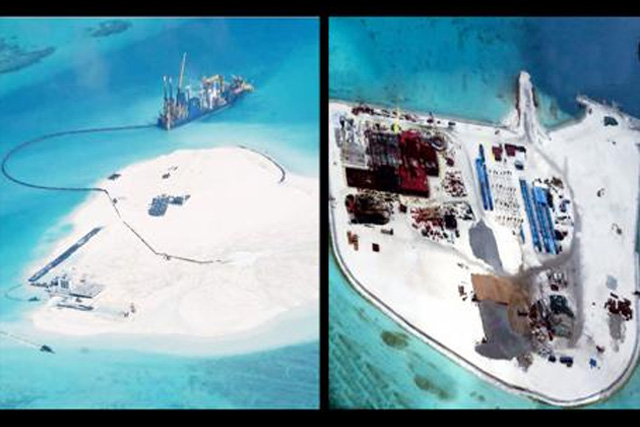
Aerial surveillance images obtained by The STAR show Ma- bini Reef in March last year (left), with only one building that served as a temporary shelter for workers. The image on the right, taken recently, shows more structures and trees planted on the reef.
China’s reef reclamation and development projects in the disputed Spratly islands in the West Philippine Sea last year have progressed by leaps and bounds, and security officials expect them to be turned into man-made islets ready for occupation by Chinese military personnel and civilians.
Armed Forces of the Philippines chief Gen. Pio Gregorio Catapang confirmed the massive development projects of the Chinese in the disputed region.
“It’s 50 percent complete. It’s alarming in the sense that it could be used for purposes other than peaceful,” Catapang said last week during the AFP-sponsored media gathering at Camp Aguinaldo in Quezon City.
He assured the public that the military is well apprised of the situation in the West Philippine Sea through sustained air and maritime patrols.
Military aerial surveillance of the area last October and November showed that the Chinese have constructed buildings, ports and a soon to be completed circumferential road at the reclaimed portion of Mabini Reef.
“It is just a matter of time before these Chinese reclaimed features will be ready for occupancy,” a security official said.
China claims the entire disputed region as an integral part of its maritime domain and embarked on reclamation projects early last year on Mabini Reef, Chigua Reef, Cuarteron Reef and Burgos Reef.
Known to local sailors as Luli (for Lulubog, Lilitaw) depending on sea conditions, these reclaimed reefs, if not within the country’s 200-nautical exclusive economic zone (EEZ), are part of the Phiippine-occupied Kalayaan Island Group (KIG) based on Presidential Decree 1596 that former President Ferdinand Marcos issued in 1978.
In the case of Mabini Reef – also known as Johnson South Reef – the area is within the country’s maritime domain as it is located 194 nautical miles from mainland Palawan and well within the country’s 200-nautical mile EEZ.
In March last year, the military spotted only a single rectangular structure that serves as temporary shelter of workers in the man-made islet that prompted the Department of Foreign Affairs (DFA) to file a diplomatic protest against Beijing.
Beijing rejected the DFA protest, maintaining that it has sovereignty over almost 80 percent of the West Philippine Sea.
The Chinese have completed a building and even planted tropical trees in the building’s front yard at the reclaimed Mabini Reef.
They have also started construction of a three-story building on the reef.
At the Kagitingan Reef (Fiery Cross Reef) China is reportedly planning to build an airstrip that could accommodate wide-bodied aircraft as well as jet fighters.
At least five giant barges and ships were spotted last November, apparently to connect an already reclaimed and heavily fortified area to an adjacent atoll in line with China’s air and naval base projects.
The Chinese have also started infrastructure development at the reclaimed Chigua Reef (Kennan Reef).
From a J-shaped reclaimed area monitored in April last year, Chigua reef – located 167 nautical miles from mainland Palawan – now has helipads and ports.
The area now looks like a modern resort facility rather than a military feature. It was gathered that aside from military facilities, China is developing tourist destinations in the Spratlys.
At the reclaimed Burgos Reef, the Chinese have also built ports and roads.
http://www.philstar.com/headlines/2015/01/12/1411996/china-builds-ports-helipads-spratly-islands

No comments:
Post a Comment
Note: Only a member of this blog may post a comment.